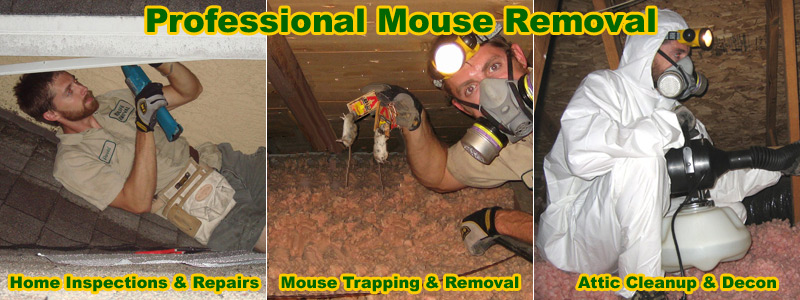Remember, first and most important - if mice are in your house or attic, it is absolutely pointless to start trapping them unless you've first found and sealed shut all the holes in your house that they are using
to get in. If you leave the entry holes open, new mice will just keep coming and coming and coming. Sealing the gaps and holes shut is top priority.
Using Snap Traps: The best method. After you've sealed the house shut so that no more mice can get in, set the traps in the areas you hear and see mouse activity in the form of droppings. Location of the trap is far more important than type of bait. Set at least
a dozen snap traps where you see the mouse activity, such as droppings or nesting material or paths or tunnels in the attic insulation. Set along walls and edges, with the trap pan facing the wall. Even though bait doesn't really matter that much, bait the traps
with peanut butter or chocolate or bits of meat like slimjim or bacon.
Using Glue Pads: I don't like glue pads. They don't always work, they're harder to set properly in order to be effective, and they're really, REALLY inhumane. The mouse just lies there, stuck, slowly starving or suffocating. C'mon man. Don't use glue boards.
 Mouse Removal Methods
Mouse Removal Methods - Main mouse removal page.
Mice In the Attic - The most common area for mice to inhabit.
How to Get Rid of Mice - A comprehensive guide for many areas of a house.
How To Kill Mice - Should you kill mice, and if so, how?
How To Trap Mice:
It is important to know where a mouse is hiding, or in which vicinity of the house, before trapping can begin. Traps must be placed astutely or they will not be successful in catching their prey. It is good to observe the pattern of destruction or mess a mouse is leaving and locate the trap near, as these are clear indicators of a rodent’s presence.
When using a standard spring-loaded trap, cheese can be used as bait. However, hard cheeses should be avoided as mice can lift these swiftly away before the trap has done its work. Instead, soft cheeses such as Brie should be opted for. Peanut butter has been known to work well due to its strong scent and very sticky substance.
A more humane way to trap a mouse is to place a cardboard ramp leading up to a bucket, and at the top of this ramp and over the bucket place a cardboard tube with some food towards the bucket end of it. The mouse will go through the tube for the food and fall into the bucket – he can then be released into a wooded area at least a mile away.
If you need help, click my
Nationwide Directory of Wildlife Professionals serving almost every
USA town, in all 50 states.
What Is The Best Trap To Catch Mouse:
Years ago when you headed to the hardware store for a solution to your pest problem you had two choices; poison or snap traps. Currently if you head to the store looking for what is the best trap to catch mouse you’ll find much more than these options. You’ll find glue traps, covered lethal traps and live traps to choose from. This will leave many of you wondering which is best for you and your troubles. There are advantages and disadvantages to any of the solutions.
If you decide to use poison the animals can die anywhere in the home with the toxins in their body. If a pet eats the dead mouse they will be exposed to the poison. They can also drag the poison around exposing pets or children to the toxin. Glue traps are popular because once a mouse steps on them they aren’t going anywhere. The downfall of glue traps is the mouse has a very slow death struggling to get free of the glue. The covered lethal traps are popular for those of you who don’t want to see or touch the dead mouse. If you’re looking to release the animal alive the only option you have are live traps. Snap traps are generally thought to be the most effective. Once you’ve decided which trap you’re going to use you’ll need to carefully select your bait and start the process of getting rid of the pests.
Lethal Mouse Traps:
There are several kinds of lethal mousetraps. The most common trap is known as the “spring-loaded” mousetrap and works by crushing the head or breaking the neck or spinal cord of the mouse, thus leading to death. Cheese or other foods like peanut butter can generally be used as bait for these traps. When reaching for the cheese, the mouse will touch the trip and the spring will be released.
Glue traps are also quite common. These are suitable for use indoors and catch the mouse by catching its feet in glue. Death is generally a lot slower with these kinds of traps, and they have been opposed by some animal rights activists.
The “mouth mousetrap” works by placing bait within a set of “jaws”. When the mouse reaches for the bait, the jaws snap shut around its body causing the spinal cord to snap and the mouse to die.
“Bucket traps” can also be used. These can be lethal or non-lethal, and work by luring the mouse into a deep container that it will not be able to get out of. The lethal version contains water, causing the mouse to drown. Poisons, caustic soda or soap may be used to speed up the killing process.